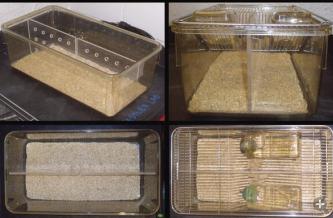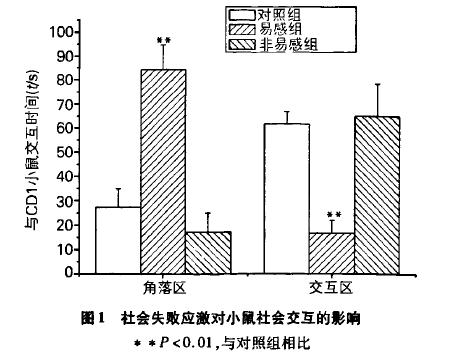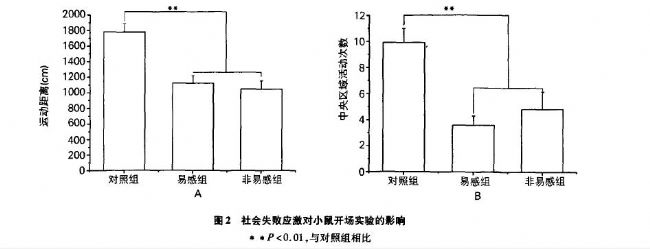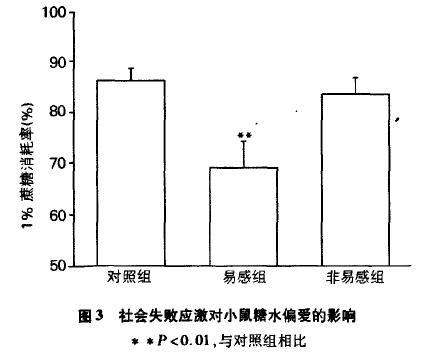Study on animal model of depression-like behavior caused by social failure stress
Summary:
Objective To explore the feasibility and effectiveness of the establishment of social depression stress depression model.
Methods C57BL/6 mice were given social failure psychological stress for 21 days. After 24 hours of stress, the mice were evaluated for depression behavior through social interaction, face, scalp and scalp. Results Compared with the control group, social failure stress led to significant anxiety-like behavior in C57BL/6 mice, while only 50%-60% of socially unstressed mice developed depression-like behaviors with social evasion and lack of interest. Susceptible to stress. The evaluation results of other stress mice were not different from those of the time-lapse group, and there was no depression-like behavior, showing stress-susceptibility. Conclusion Through social disability stress, it provides a solid basis for the establishment of a new animal model of depression.
Key words : social failure; susceptibility phenotype; depression; model; animal; stress;
Depression is one of the chronic multi-inferior mental diseases caused by the combination of individual genetic quality and living environment. The global incidence rate is as high as 20% and has a high recurrence rate. Not only do patients have a severely affected quality of life, but they can also lead to extreme behaviors such as suicide, which impose enormous medical and economic burdens on society. At present, little is known about the pathophysiological mechanisms of depression. One of the important causes of depression in life as a cause of depression is the recognized fact. However, most individuals in the group still maintain normal psychological and cognitive functions after encountering unfortunate or major stress events, exhibiting resilience to stress and not inducing depression. From this point of view, studying the molecular and cellular mechanisms of individual resistance to stress may provide important ways and ideas for the pathophysiology of depression and antidepressant effects to be elucidated. At present, there are relatively few studies on the molecular mechanisms of stress resistance at home and abroad. One of the reasons is that the currently used animal models of depression have certain limitations.
In this study, the stress group was screened into two subgroups of stress susceptibility and non-susceptibility by applying social failure psychological stress to C57BL/6 mice and behavioral evaluation. In the stress-susceptible subpopulation, mice showed significant social evasion and depression-like behavior with loss of interest, accompanied by significant anxiety behavior; in the stress-susceptible subpopulation, mice only showed significant anxiety behavior, and there was no Depression-like behaviors with social evasion and lack of interest appear to be significantly stress-resistant. The question of what causes the same level of behavioral stress caused by the same stress remains to be further explored. Recently, some scholars have reported that the brain-edge dopaminergic neurons in the brain reward circle may mediate the stress susceptibility and anti-depression effect caused by social failure stress, and also establish the structure of animal depression model using social failure in this study. The discussion of sexuality, apparent validity and predictive validity provides a basis. Through the social failure stress model, it is not only possible to establish a stable animal model for studying the pathophysiology of depression, but also to study the molecular and cellular mechanisms of stress-resistant individuals.
Materials and Method
1.1 experimental animals
6-7 weeks old clean male C57 BL/6 mice were purchased from the Animal Center of the Academy of Military Medical Sciences; 8-9 months old male retirement CD1 mice were purchased from Beijing Weitong Lihua Experimental Animals Co., Ltd.; (23 soil 2) `C, fluorescent lighting 7:00 to 19: 00, stress time 16:00-18: 30, behavioral evaluation time 8: 00-12:000
1.2 drugs and reagents
Sucrose was purchased from Xiqiao Chemical Co., Ltd. (batch number: 1001202); anhydrous ethanol was purchased from Sinopharm Chemical Reagent Co., Ltd. (batch number).
1.3 method
1. 3.1 Social failure Stress Before the experiment, the mice were randomly divided into the control group and the stress group. The stress group C57BL/6 mice were used as invaders in the cages of long-term single CDl mice. After 10 min of exposure, C57 BL/6 mice will be attacked by CD1 mice within 10 min and exhibit behavioral characteristics such as escape, fear and compliance. After 10 minutes of physical contact, the plexiglass plates with transparent and many small holes were used to separate the two for psychological stress for 24 h, ensuring that C57 BL/6 mice could see CD1 mice and hear the sound of CD1 mice. And can smell the smell of CD1 mice, the stress lasts 21 days.
After the stress was over, C57 BL/6 mice were housed individually for behavioral evaluation. The control group was housed in an equivalent squirrel cage, two control C57BL/6 mice were paired in pairs, and each mouse was placed in the palm for 30 s per day. After the stress in the stress group was over, the control mice were also housed separately.

1.3.2 Opening experiment The mice were placed in the center of the 42 cm x 42 cm x 25 cm open field and allowed to freely move for 5 min. The whole process of the experiment was recorded using a camera system, and the number of times and the total distance of movement of the mouse through the central region within 5 min were recorded. The video was analyzed using Shanghai Xinsoft SuperMaze software. After each experiment, each field was wiped with 75% ethanol and thoroughly dried to avoid affecting the experiment in the next mouse.
1.3.3 Social interaction experiment The social interaction experiment is divided into two phases, each phase 2. 5 min. The experiment was carried out in the opening of 42 cm x 42 cm x 25crn. In the first stage, C57 BL/6 mice were randomly placed at the two corners of the distal end of the predefined interaction area. A 3 cm x 6 cm x 25 cm plastic transparent box filled with small holes was placed in the interaction area. No CD1 mice were placed in the box. In the second stage, a CD1 mouse was placed in a transparent capsule, and the C57 BL/6 mice were returned to the opening field to observe the interaction between C57BL/6 mice and CD1 mice. The experimental procedure was recorded using a camera system, and the Shanghai Xinsoft SuperMaze software was used to analyze the dwell time of the mouse in the predefined interaction area and the time spent at the two corners of the interaction area and its motion trajectory.
1.3.4 syrup preference experimental social failure stress until the 19th day, C57 BL/6 mice were given 2 bottles of drinking water for selective drinking, after 2 days, then replaced with 2 bottles of 1% sucrose solution, the same Then selectively adapt to 2d. After selective drinking water was used for Sd, the sugar water preference experiment was officially carried out, and a bottle of drinking water and a bottle of 1% sucrose solution were given to the mice. After 24 hours, the consumption of each water bottle was weighed. The test was carried out for 2 days, and the drinking water bottle and the sucrose solution bottle were interchanged every day to eliminate the error that the position preference may bring.
1.3.5 Statistical Methods All data were expressed by means of t test, one-way ANOVA and two-factor factorial design for significance test. The Dunnet t test was used for comparison between groups. The significance test level is set to P<0.01
2 results
2.1 The impact of social failure stress on social interaction in mice
In the second phase of the mouse social interaction experiment, when the CD3 mice were present in the open box, compared with the control group and the social failure stress non-susceptibility group, the stress-susceptible group mice were in the CD1 mice. The residence time at the two corners of the distal part of the interaction area increased significantly (p<0.01), while the residence time in the area where the social interaction with the CD1 mice was socially significantly shortened (P<0.01), showing obvious social evasion. Depressive behavior. In the experiment, it was directly observed that C57BL/6 mice showed obvious fear response when they saw CD1 mice, and quickly fled to the distal corner, and the breathing was short. Conversely, non-susceptible C57BL/6 mice that were subjected to equal stress did not differ from the control group at the two corners of the distal region of the interaction zone with the CD1 mouse at the residence time and social interaction. Proactive social interactions in contact with CD1 mice (Figure 1).

2. 2 The impact of social failure stress on the opening experiment of mice
In the opening experiment, compared with the control group, the socially challenged mice had a significantly shorter exercise distance (P<0.01), while they stayed longer in the four corners of the field (Fig. 2A), and entered the central area. The number of times also decreased significantly (P < 0.01), and the active exploration behavior decreased (Fig. 2B). There was no difference between the stress-susceptible group and the non-susceptible group in the distance of movement and the number of activities in the central area, indicating that social failure stress caused anxiety-like behavior in mice.

2. 3 The impact of social failure stress on mouse syrup preference
In the saccharification preference experiment, the results were consistent with the results of social interaction behavior. Compared with the control group and the non-susceptible group with social failure stress, the ratio of sucrose water consumption to total drinking water in the stress-susceptible group was significantly decreased (P<0.01), which showed a significant lack of interest in depression. The ratio of sucrose water consumption to total drinking water in the non-susceptible group was not different from that in the control group. The amount of sucrose drinking water was relatively high, showing obvious saccharification behavior and no loss of interest (Fig. 3).

3 Discussion
Stress is one of the important causes of depression. In the pathophysiological study of depression, the animal models commonly used at home and abroad are chronic mild stress, acquired helplessness and social failure stress models. Although both acquired helplessness and chronic mild stress can achieve long-term changes in behavioral, neurosecretory, and neurobiological effects, these two modeling approaches are somewhat non-social stresses. Usually, the physiological and psychological changes that induce depression in humans are mostly social stresses. Therefore, social failure stress is used to better simulate the way in which human depression occurs, and animal models are established to explore the etiology of depression. It is very necessary. In addition, reports by Covingto et al. Krish~ et al. show that social failure stress leads to long-term latent depression caused by lack of interest and social evasion. It can correct depression caused by social failure stress through chronic rather than acute anti-depression treatment. Our related research results are also consistent with this (will be reported separately).
Depression is a heterogeneous disease in which patients can exhibit a variety of symptoms, including depression, loss of worth, loss of interest, pessimism, repeated suicidal thoughts, insomnia, or lethargy. Usually, depression patients do not show all symptoms of depression. Therefore, an ideal animal depression model does not need to have all abnormal depression-related behaviors. Loss of interest is one of the core symptoms of depression. At present, the establishment of most animal depression models will lead to the lack of interest as an important indicator of depression behavior evaluation. In this study, we adopted social failure stress, which led to the decline of exploratory behavioral ability in the stressed mice, the significant improvement of social escape behavior, and the depression-like behavior of sucrose drinking preference, indicating that the stress pattern can be well simulated. The actual situation of depression induced by human social stress, while reflecting the apparent effectiveness of social failure stress to establish an animal model of depression behavior.
In this study, behavioral evaluation of mice in the same amount of social failure stress group found that only 50% to 60% of mice in the same group were subjected to stress effects under the same psychological stress. It led to the occurrence of depression behavior, and social escape and loss of interest behavior, while other mice showed normal behavior, and did not appear above. After analyzing the experimental results, it is considered that the occurrence of this situation is consistent with the occurrence of human depression. As mentioned above, depression is a heterogeneous disease. In the same population, although the environment may be the same and the stress effects are the same, the same stress does not produce the same result due to differences in genetic levels between individuals. Although the “depression gene†has not yet been identified, the interaction between disease and genetics and the environment is an indisputable fact, and the occurrence of depression is no exception. Therefore, in our social failure stress test, 40% -50% of the mice did not show a loss of interest in social escape and sucrose preference, that is, some mice in the group showed stress resistance without depression. The result is normal and inevitable. This result is also consistent with the report of Krishnan et al. in 2007, which better simulates some core manifestations of depression, and also provides a certain experimental basis for the study of the genetic basis of stress-resistant individuals. Wilkinson, Lagace, and Vialou have been reported in the context of social failure stress to study the cellular and molecular mechanisms of stress resistance. For example, Vialou et al. demonstrated that the mouse transcription factor △E'osB mediates social failure stress. Stress resistance mechanism. These studies objectively demonstrate the value of using animal failure stress to establish animal depression models in elucidating the pathophysiological study of depression and the predictive validity of animal models.
In summary, stress is one of the important causes of depression. The lack of reliable and effective animal models of depression is a major obstacle to the exploration of the physiological and pathological mechanisms of depression. Social failure stress establishes a model of depression-like behavioral animal model, which provides a certain experimental basis for the establishment of a new model of animal depression behavior. At the same time, it also provides a new research idea and direction for the study of depression mechanism. On the one hand, the molecular mechanism of the depressed animals is explored, and on the other hand, the resistance mechanism of individuals who are resistant to stress is studied. This parallel research strategy contributes to the elucidation of the molecular mechanisms of depression and provides a basis for the development of more effective and sustained antidepressants.
FACE Mask 3D style
3D Face Mask,3D Face Mask Covid,3D Animal Face Mask,3D Face Mask Black
Zhejiang Lanhine Medical Products Ltd. , https://www.lanheyiliao.com